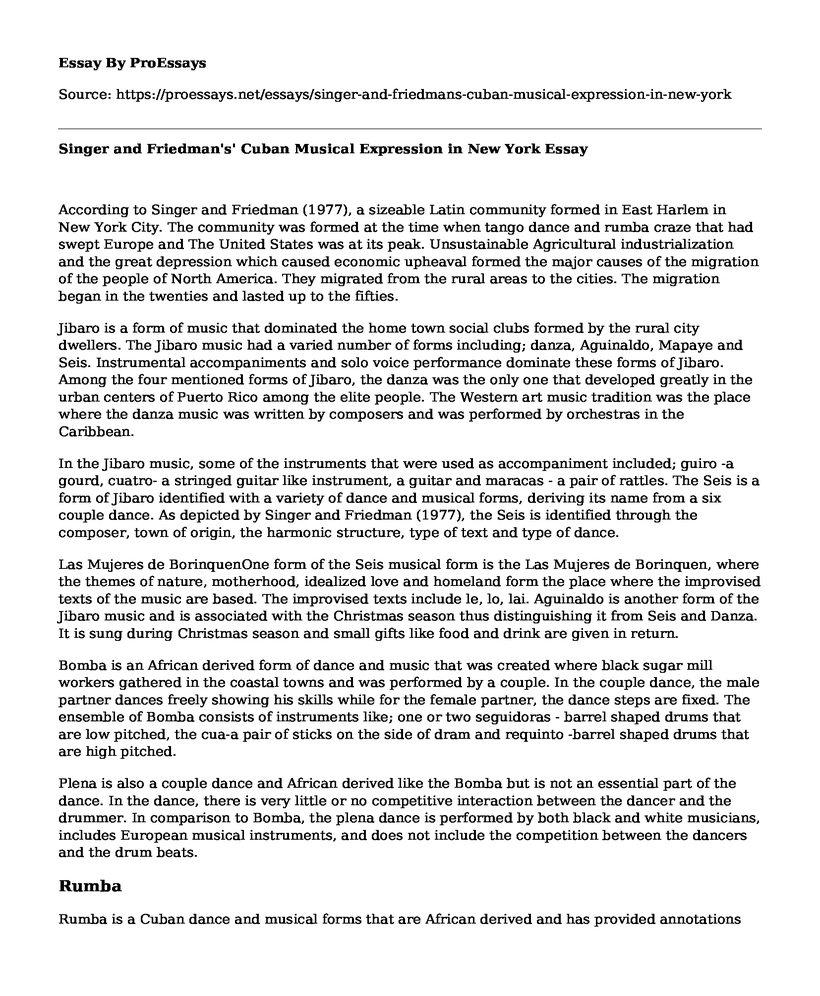According to Singer and Friedman (1977), a sizeable Latin community formed in East Harlem in New York City. The community was formed at the time when tango dance and rumba craze that had swept Europe and The United States was at its peak. Unsustainable Agricultural industrialization and the great depression which caused economic upheaval formed the major causes of the migration of the people of North America. They migrated from the rural areas to the cities. The migration began in the twenties and lasted up to the fifties.
Jibaro is a form of music that dominated the home town social clubs formed by the rural city dwellers. The Jibaro music had a varied number of forms including; danza, Aguinaldo, Mapaye and Seis. Instrumental accompaniments and solo voice performance dominate these forms of Jibaro. Among the four mentioned forms of Jibaro, the danza was the only one that developed greatly in the urban centers of Puerto Rico among the elite people. The Western art music tradition was the place where the danza music was written by composers and was performed by orchestras in the Caribbean.
In the Jibaro music, some of the instruments that were used as accompaniment included; guiro -a gourd, cuatro- a stringed guitar like instrument, a guitar and maracas - a pair of rattles. The Seis is a form of Jibaro identified with a variety of dance and musical forms, deriving its name from a six couple dance. As depicted by Singer and Friedman (1977), the Seis is identified through the composer, town of origin, the harmonic structure, type of text and type of dance.
Las Mujeres de BorinquenOne form of the Seis musical form is the Las Mujeres de Borinquen, where the themes of nature, motherhood, idealized love and homeland form the place where the improvised texts of the music are based. The improvised texts include le, lo, lai. Aguinaldo is another form of the Jibaro music and is associated with the Christmas season thus distinguishing it from Seis and Danza. It is sung during Christmas season and small gifts like food and drink are given in return.
Bomba is an African derived form of dance and music that was created where black sugar mill workers gathered in the coastal towns and was performed by a couple. In the couple dance, the male partner dances freely showing his skills while for the female partner, the dance steps are fixed. The ensemble of Bomba consists of instruments like; one or two seguidoras - barrel shaped drums that are low pitched, the cua-a pair of sticks on the side of dram and requinto -barrel shaped drums that are high pitched.
Plena is also a couple dance and African derived like the Bomba but is not an essential part of the dance. In the dance, there is very little or no competitive interaction between the dancer and the drummer. In comparison to Bomba, the plena dance is performed by both black and white musicians, includes European musical instruments, and does not include the competition between the dancers and the drum beats.
Rumba
Rumba is a Cuban dance and musical forms that are African derived and has provided annotations means on social and political issues since the slavery times. Columbia, Yambu and Guaguanco form the parts or forms of Rumba. Son is an informal type of entertainment in gatherings and has no formal structure but rather involves feeling and specific types of instrumentation (Singer and Friedman, 1977).
Son was developed in the nineteenth century by black people who dwelled in the country side of Cuba. As illustrated by Singer and Friedman (1977), the music spread to the urban areas and was favored by the whites especially as an entertainment in social gatherings. The amalgamation of guajira - a Cuban music derived from Spain, formed the milestone in the evolution of the Son music to the urban areas from the country side.
Salsa, according to Singer and Friedman, (1977), is the music and dance form in which performers involve feelings that are savory or spicy thus involving the soul in the music and dance. The small sizeable Latin community that was developing in New York gave the Salsa music and dance moves audience.
References
Singer, R., & Friedman, R. (1977). Puerto Rican and Cuban musical expression in New York'. Liner Notes to New World Records, 244.
Cite this page
Singer and Friedman's' Cuban Musical Expression in New York. (2022, Mar 09). Retrieved from https://proessays.net/essays/singer-and-friedmans-cuban-musical-expression-in-new-york
If you are the original author of this essay and no longer wish to have it published on the ProEssays website, please click below to request its removal:
- Negative Impacts of Social Media in the Society Essay
- The Disposition by Michelangelo - Critical Essay
- Deconstruction on Survivor the Great Lie S7 E11
- Beast of No Nation: A Stereotypical Representation of Africa Essay
- National Geographic: The Photographic Vision Essay Example
- Essay on The Dangers of a Single Story: Chimamanda Ngozi Adichie's Powerful 20-Minute Video
- Paper Example on Nostalgic Fishing Vacation on a Sunny Day







